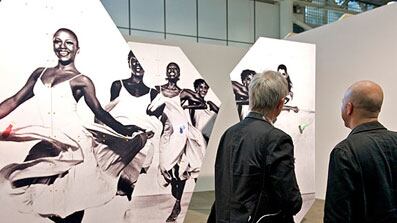Every passenger on the Swissair flight was given a miniature chocolate football as we approached Basel. “I didn’t even know the Swiss played football,” grumped a Brit. Once we landed, I headed straight for Zurich and Zaha Hadid and Suprematism at the Galerie Gmurzynska on Paradeplatz. Examples of the Iraqi-born British architect’s Design art—a spaceflight-ready fireplace included—were installed alongside pieces by Kazimir Malevich, Alexander Rodchenko, and El Lissitzky, exploding in a black & white continuum, which Hadid had devised on a computer. Walking into the place was a rush. “It’s like Jeff Koons’ BMW,” enthused Hadid’s London dealer, Kenny Schachter.
Click here to VIEW OUR GALLERY of Art 41 Basel exhibits.

The germ of this long-in-the-making exhibition was The Great Utopia, the show that Hadid had designed for the Guggenheim on Fifth Avenue in 1992. Eighteen years later, Hadid is a starchitect, and one of the few female über-artists, but back then the current amour between Fine Art and Design was barely a glimmer in the market’s eye, and Hadid was still working on what would be her first project to actually be built: the Vitra Fire Station in Weil am Rhein, Germany. “I was presenting the design,” she told me, which was completed in 1994 on the grounds of the Vitra furniture and design manufacturing complex.
On to Basel, and the plunge into the main fair.
Faces without which an art event would seem lacking in heft—Don and Mera Rubell, Peter Brant, Roman Abramovich, David Nahmad, Tim Hunt of the Warhol Foundation—circled like gulls above a fish-rich ocean, along with such newbies as Bianca Jagger. Indeed, the action was heavy enough that the dealers didn’t have to pretend to be happy.
But it wasn’t just trophy-hunting; it was up and down the scale. Hauser & Wirth sold two sets of Paul McCarthy’s Dwarves for €3 million ($3.7 million) apiece and were breaking up a third set piecemeal; the London gallery Anthony Reynolds sold a 2004 Elaine Sturtevant Licorice Marilyn, a repainting of the Warhol icon, for a remarkable €140,000; and Lehmann Maupin sold several Tracey Emin Neons and a blanket.
Some dealers, perhaps pistol-whipped by the last two years, have been muttering that the art world was perhaps just climbing the middle bit of a “W” rather than ascending a “V.”
“It isn’t just jet-setters on the first day,” says Michael Briggs of the Los Angeles gallery Patrick Painter. “The weekend is good at Basel. There are a lot of professional people here. Doctors, lawyers. They take their time.” He added that last year, crunch year, had not adhered to this pattern. “We did nothing in the first day and then we sold everything at the end of the week,” he said
Gavin Brown said every year was different, but that he expected the results would show that they had sold 40 percent on their first day. Georg Kargi, a Vienna dealer, said, “It is different here. It is not just about the names in the papers. Here it is more European style. I’ve got nothing against American style, but it is different.”
As to the statelier European rhythms, Florian Berktold of Hauser & Wirth, observed that the Euros were not immune to Miami-like fevers. “Four years ago it was crazy in the first hour,” he said. Holds—the length of time a gallerist would hang onto a picture while the collector made up his or her mind—could be as short as a few hours. Indeed, I remember talk of the infamous “two-minute hold.”
Among the great stuff was a bewitching display of translucent work by Sigmar Polke, who died of cancer just a few days before this year’s opening. And the good stuff included The Lost Astronaut, a video installation by Alicia Framis, which was at once haunting and hilarious. There was also a (real) sand bank set with deck chairs beneath a tent and a screen upon which played a movie by Agnes Varda. It should tell you a fair amount about the appetite of the new art world that this 82-year-old veteran French movie director, the widow of Jacques Demy, has reconfigured herself as an artist. I asked her what her film-making plans were.
“Theatrical films?” A Gallic shrug. “No! But art, yes. I have many projects.”
On to Schaulager to see the Matthew Barney. Eva and Adele, the Art Couple, were on my tram, both in high-collared baby-pink dresses. “These aren’t easy for the tram,” Eva fretted. My VIP card was worthless on the line but my press badge got me straight in. There was Nick Serota of the Tate, and, to my surprise, Matthew Slotover and Amanda Sharp of Frieze, the London fair.
The subsidiary fair, Volta, was crackling; there, I ran into Katelijne de Backer of the Armory.
“I didn’t think you guys went to each other’s fairs,” I said.
“We have to watch what the opposition is up to … ” de Backer twinkled, as she spun off.
Back to the main event and the Marlborough stand, where a Securitas guard was standing behind a white chain in front of three flawless black Ad Reinhardts. I remarked upon the guards to the Marlborough Gallery’s Gilbert Lloyd, who was at the desk.
“We don’t want anybody to touch one of the Reinhardts,” he said.
“It would damage it?”
“It would absolutely wreck it,” he said.
A sensible precaution in that case.
That evening in the bar at the media center, I sat with Richard Phillips and Josepine Meckseper, watching Switzerland play Spain in the World Cup. Both artists were knowledgeable spectators, down to certain U.K. problems in the goalkeeping department. Switzerland’s unexpected victory had the art world convulsing too.
Brett Gorvey, the international co-head of contemporary art at Christie’s, sat in that same bar a while later, as did Harry Blain, who had founded the Haunch of Venison gallery, along with Graham Southern. Christie’s acquired the Haunch in February 2007, a notorious coup, which had caused the gallery to be banned from all “serious” art fairs, including Art Basel and Art Basel Miami.
Just a few days ago I had heard via Josh Baer’s The Baer Faxt that Blain and Southern had left Christie’s; there were clouds of speculation as to just why.
I said to Blain that I had heard that Haunch would be leaving its space in Burlington House.
“You know we’ve left Haunch?” he said, adding that they would be opening a new space elsewhere.
What would he call it?
“I don’t know. Something simple like ‘Blain’s,’ ” Harry said. A half-joke. “Come to the opening.”
And Christie’s?
“It was all very amicable,” he said, turning his attention to another guy with us at the bar to ask what the gentleman did.
“I work for the enemy,” he replied, sunnily, introducing himself as Alexander Montague-Sparey of Christie’s photographic department.
The whole passage, at once slow and instantaneous, was superbly polite in the haute-Anglo fashion. But it was what Henri Cartier-Bresson might have described as a “decisive moment,” and an art fair moment for sure.
Plus: Check out Art Beast, for galleries, interviews with artists, and photos from the hottest parties.
Anthony Haden-Guest is the news editor of Charles Saatchi’s online magazine.






